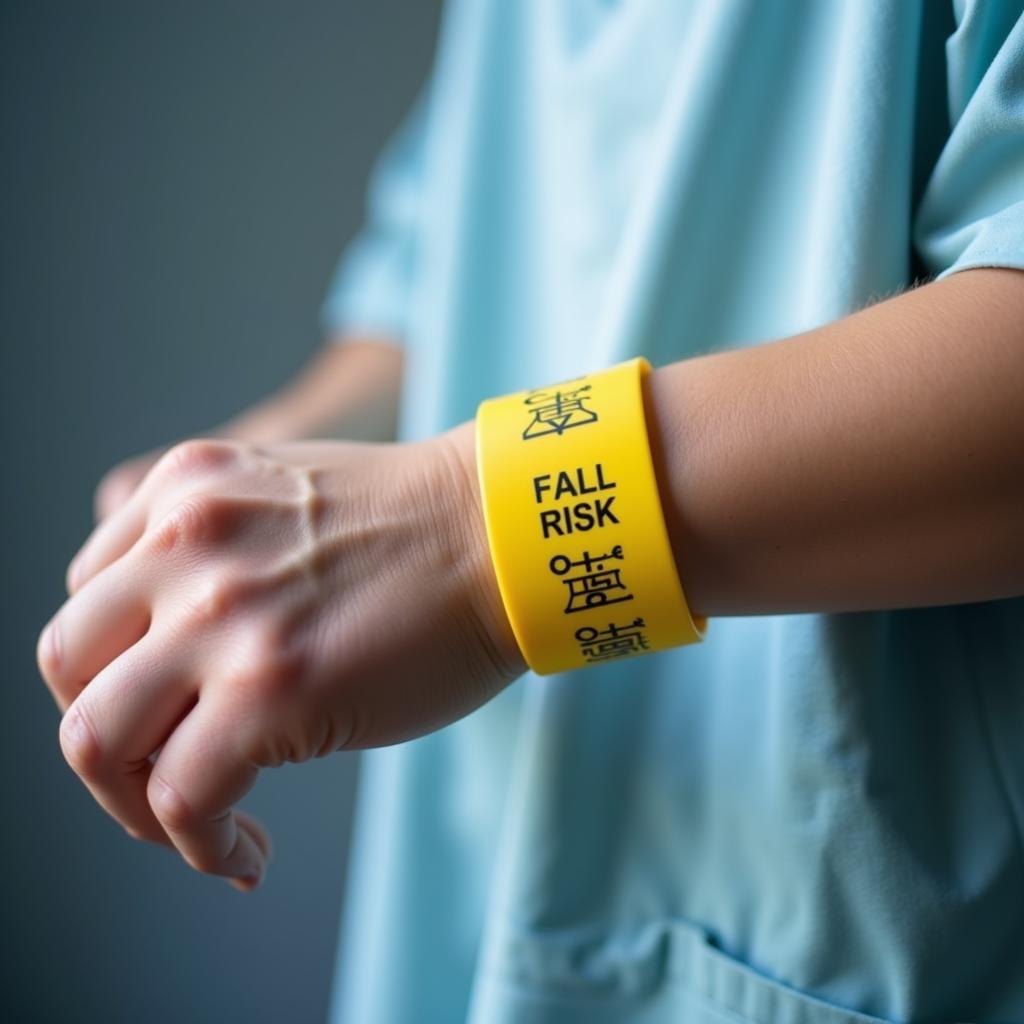Fall risk bracelets at hospitals are a crucial safety measure designed to prevent falls among patients identified as being at high risk. These bracelets, often brightly colored (like yellow or red), quickly alert hospital staff to a patient’s increased fall risk, enabling them to provide extra attention and support. This proactive approach significantly contributes to patient well-being and a safer hospital environment. fall risk hospital bracelet
Understanding the Importance of Fall Risk Bracelets
Falls in hospitals are a significant concern, posing risks of serious injuries such as fractures, head trauma, and soft tissue damage. Fall risk bracelets play a vital role in minimizing these risks. They serve as a constant visual reminder to staff, visitors, and even patients themselves to exercise caution and take necessary precautions. These precautions can include assisting with mobility, ensuring a clutter-free environment, and providing frequent checks on the patient.
 Hospital Patient Wearing Fall Risk Bracelet
Hospital Patient Wearing Fall Risk Bracelet
Who Needs a Fall Risk Bracelet?
Several factors can contribute to a patient’s fall risk. These include age, medical conditions, medications, history of falls, cognitive impairment, and mobility issues. A thorough assessment by a healthcare professional determines whether a patient requires a fall risk bracelet. This assessment typically involves evaluating the patient’s balance, gait, muscle strength, and overall physical and cognitive function.
What does a Fall Risk Bracelet At Hospital signify? It means the patient requires special attention and precautionary measures to prevent falls.
How Fall Risk Bracelets Improve Patient Safety
Fall risk bracelets are more than just a visual cue. They are part of a comprehensive fall prevention strategy that encompasses a range of interventions. These interventions can include:
- Regular monitoring of the patient
- Assistance with ambulation and transfers
- Ensuring adequate lighting and a clutter-free environment
- Education for the patient and their family about fall prevention strategies
- Physical therapy and occupational therapy to improve balance and strength
Beyond the Bracelet: A Holistic Approach to Fall Prevention
While fall risk bracelets are essential, they are most effective when integrated into a broader fall prevention program. This program should involve regular staff training, clear communication protocols, and continuous evaluation of fall prevention strategies.
“A truly effective fall prevention program goes beyond simply identifying at-risk patients. It requires a collaborative effort from the entire healthcare team, including physicians, nurses, therapists, and even family members,” says Dr. Emily Carter, a leading geriatrician. This holistic approach ensures that every aspect of the patient’s care contributes to their safety and well-being.
Fall Risk Assessment and Bracelet Application
The process of assessing fall risk and applying a fall risk bracelet is standardized to ensure consistency and accuracy. This typically involves using a validated fall risk assessment tool, followed by documentation of the assessment findings and application of the bracelet. The patient and their family are also educated about the significance of the bracelet and the precautions being taken.
What are the Different Colors of Fall Risk Bracelets?
Different hospitals might use different color codes for fall risk bracelets. While yellow is commonly used, some hospitals may use red, orange, or even a combination of colors. It’s always best to ask the hospital staff what their color coding system signifies. Knowing this helps everyone involved in the patient’s care understand the level of precaution required.
“Consistent communication about the meaning of these bracelets is paramount for patient safety. Everyone needs to be on the same page,” adds Dr. Carter. This clear communication helps prevent confusion and ensures that the bracelet effectively communicates the patient’s fall risk to all healthcare providers.
In conclusion, the fall risk bracelet at hospital is a vital tool in protecting vulnerable patients. By combining this visual identifier with comprehensive prevention strategies, hospitals can create a safer environment and significantly reduce the risk of falls and associated injuries. que significa una pulsera amarilla en un hospital Remember, proactive measures are crucial for patient safety and peace of mind.
FAQ
- What is a fall risk bracelet?
- Who needs a fall risk bracelet?
- What color are fall risk bracelets?
- How can I help prevent falls in the hospital?
- What should I do if I see a patient with a fall risk bracelet who appears to be struggling?
- Are fall risk bracelets used in settings other than hospitals?
- How often is a patient’s fall risk reassessed?
Need support? Contact us at Phone Number: 02437655121, Email: irccsanjose@gmail.com or visit us at 298 Cau Dien St., Minh Khai, Bac Tu Liem, Hanoi, Vietnam. We have a 24/7 customer service team.
 using WordPress and
using WordPress and